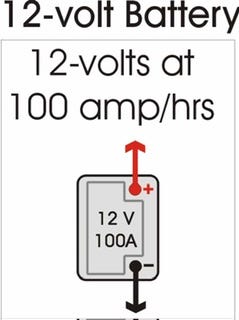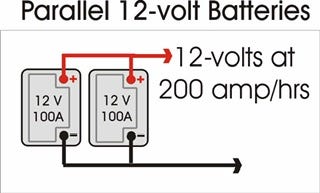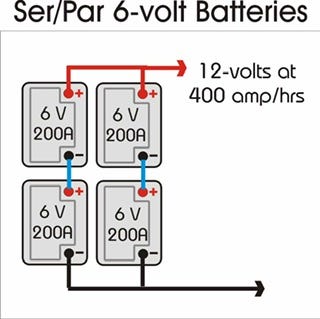Dear Readers,
This is a continuation of a previous JAM session where I discussed the possible spots to place a disconnect switch. Well, I had more than a dozen readers ask the next logical question about how does putting 6- and 12-volt batteries in various series, parallel and series/parallel arrangements cause the voltage and amperage to add up. So I modified my previous graphics a bit, and here we are.
Safety First!
While it’s certainly possible to create a bank of more than four batteries, for the purposes of this JAM Session we’ll stick with 1-, 2- and 4-battery hookups.
Let me note right up front that working with batteries can be extremely dangerous, and not from heart-stopping shocks like can occur with 120-volt circuits. No, it’s the amperage that can get you, either by welding and heating up to cherry-red temperatures anything that gets between your wrench and frame, such as your wedding ring. As I’ve noted before, I witnessed this up close and personal in a car repair shop when I was a kid. No, it wasn’t me, but the other mechanic on duty at the time.
Alternately, you can have a battery explode in your face if you short it out with a big wrench. So if you’re not comfortable taking the proper safety precautions, please hire a professional.
First, a quick review of the two battery parameters we’ll discuss today: voltage and amp/hour capacity. Voltage is simple, since it’s just a measure of electrical pressure and your RV wants 12 volts. Nope, 6 volts won’t work and 24 volts really won’t work. We’re looking for 12 volts to power our DC systems, so that’s what we’ll cover here.
Amp-hour (Ah) capacity is basically how many amperes of current a battery can supply for an hour. So a 100 amp-hour battery can supply 100 amperes of current for 60 minutes before it’s totally exhausted. But you don’t want to discharge your lead-acid or AGM batteries much below 50% of capacity or you’ll really cut down their life span. So a 100 amp-hour battery has about 50 amp-hours of usable energy before it’s been depleted to a safe level.
One 12-Volt Battery
Here’s the basic single 12-volt battery that probably came with your RV. Doesn’t matter if it’s a flooded-cell, AGM or Lithium battery, the series/parallel equations work for all of them (but a Lithium battery can usually be discharged down to the 0% level without damage).
Yes, it’s rated for 100 amp-hrs at 12 volts, so your RV electrical system is happy. However, this may not be enough run time of your residential refrigerator or microwave when boondocking (operating without hookups), so many RV owners opt for adding more batteries.
Two 12-Volt Batteries
In the second example we simply add another 12-volt battery that has a 100-Ah capacity in parallel with the first battery. And you can see that the 12-volt potential stays the same, but now there’s twice as much amp/hour capacity. It’s like carrying a spare gas tank for your RV that doubles the amount of fuel. In this case you’re doubling the amount of available electrons to do work. Hence, a pair of 12-volt, 100-Ah batteries in parallel become a 12-volt, 200-Ah battery bank. Still with me? Now it gets a little more complicated.
Two 6-Volt Batteries
What if we take a pair of 6-volt batteries that are rated for 200 Ah each and want to make them produce 12 volts instead of 6 volts. Well, you just stack them up in series like D-cells in a flashlight. And the voltage does indeed add up, so 6 volts plus 6 volts equals 12 volts of potential. However, the total Ah capacity does not add together, it stays the same as a single 6-volt battery. So in our example the two 200-Ah batteries in series make 12 volts, but the amp-hour capacity remains at 200 amp-hours. But that 200-Ah capacity can double the run time of your appliances compared to the single battery that came with your RV, so it’s good thing.
Four 6-Volt Batteries
Finally, let’s assume you’ve won the lottery and just bought four 6-volt batteries with 200-Ah capacity each. As you can see, first we stack a pair of them in series to create 12 volts of potential, then put the series stack in parallel so the Ah capacity doubles. So four of the 6-volt, 200-Ah batteries become a 12-volt/400-Ah battery bank with 4 times the capacity of the original single 12-volt battery that came with your RV. Of course, you also need room to mount them, etc., but that’s not part of this JAM Session.
Please let me know if this helps you all understand battery arrangements a little better.
That’s a wrap…
OK, everyone. Remember that electricity is a useful and powerful force, so we all need to pay attention to safety precautions while using it.
Let’s play safe out there…. Mike











Somewhat related...if I put 4 100ah Lithium batteries in a series circuit and charge them with a 48 volt charger, how will the batteries stay individually balanced?
A few things to take into consideration when charging batteries in parallel. Good connections are extremely important, a dirty, bad or loose connection, will effect the charging/discharge rate of each bank. Keep all wiring the same gauge and as close to the same length. Avoid replacing just one bank at a time, when replacing both banks make sure they are of the same manufacturer, amp rating, and date codes. In a parallel circuit voltage stays the same and current will divide, by not adhering to all of the above the weaker set will not receive the same charge as the stronger set, the stronger set may be overcharged. If using flooded batteries it is important to monitor liquid levels monthly, adding more distilled water to one bank in parallel every month could mean that there is an issue with the other bank.